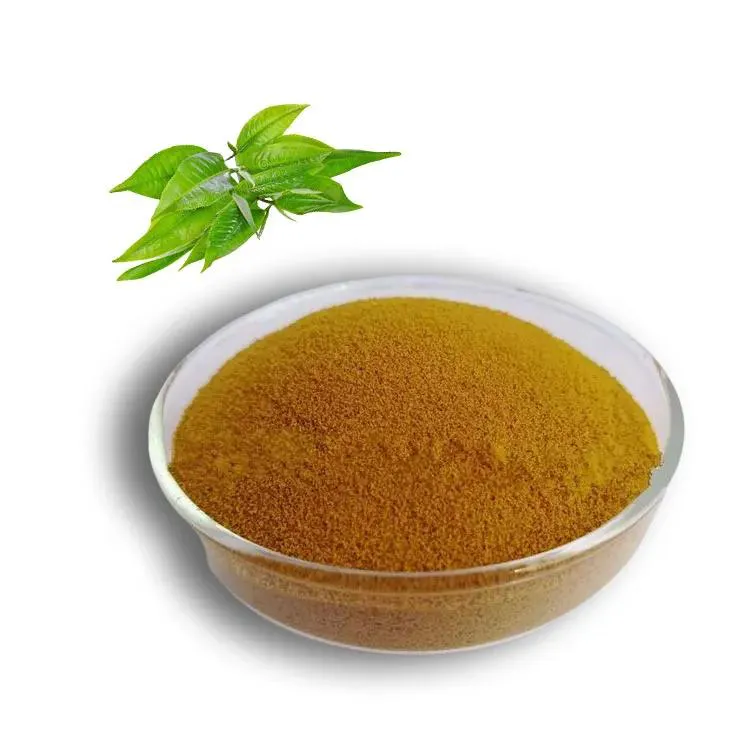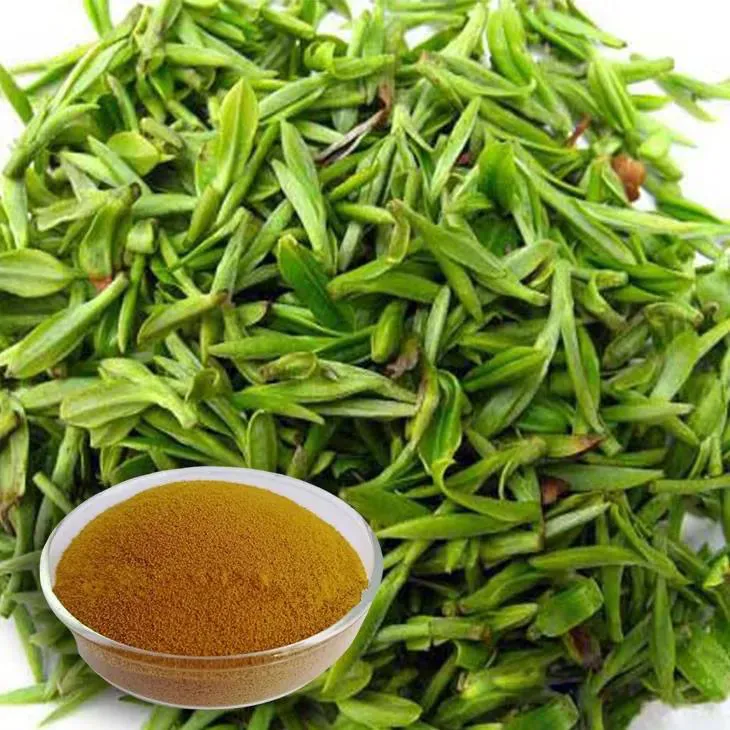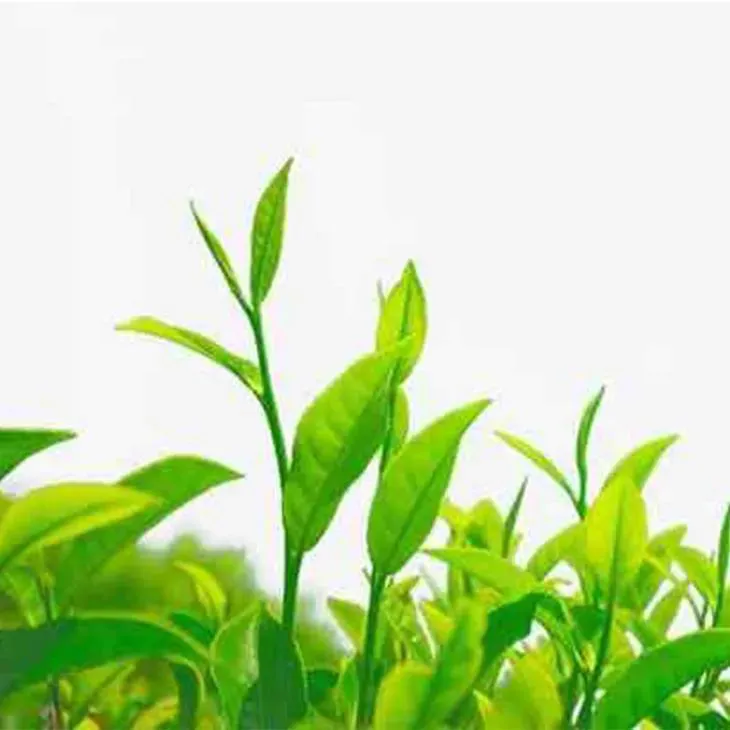- 0086-571-85302990
- sales@greenskybio.com
The process of extracting green tea catechins from green tea extract.
2024-11-28

1. Introduction
Green tea has long been recognized for its numerous health benefits, which are largely attributed to the presence of catechins. Green tea catechins are a group of polyphenolic compounds that possess antioxidant, anti - inflammatory, and other bioactive properties. Extracting these catechins from Green Tea Extract is a crucial process in various industries, including pharmaceuticals, nutraceuticals, and functional food development. This article will explore the detailed process of extracting green tea catechins from Green Tea Extract.

2. Preparation of Green Tea Extract
Before the extraction of catechins, green tea leaves need to be processed to obtain the green tea extract. The process typically involves the following steps:
2.1 Harvesting
Green tea leaves are carefully harvested at the appropriate time. The quality of the leaves at the time of harvest significantly affects the composition of the subsequent extract. Young and tender leaves are often preferred as they tend to have a higher concentration of catechins and other beneficial compounds.
2.2 Withering
After harvesting, the leaves are spread out to wither. This process reduces the moisture content in the leaves and initiates certain biochemical changes. During withering, the leaves lose some of their water content, which helps in concentrating the internal components.
2.3 Fixation
Fixation is a crucial step to prevent the leaves from further oxidation. It is usually achieved by heating the leaves, either through pan - firing or steaming. This process inactivates the enzymes in the leaves that would otherwise cause excessive oxidation, which could lead to a decrease in the quality of the extract and the catechin content.
2.4 Rolling
The fixed leaves are then rolled. Rolling helps to break the cell walls of the leaves, which facilitates the release of internal components during the extraction process. It also gives the tea leaves their characteristic shape.
2.5 Drying
Finally, the rolled leaves are dried to further reduce the moisture content. The dried leaves can then be used to prepare the green tea extract. There are different methods for preparing the extract, such as infusion or solvent extraction.

3. Selection of Extraction Method
The key step in extracting catechins from the green tea extract is choosing the right extraction method. There are several methods available, but solvent - based extraction is one of the most commonly used.
3.1 Solvent - Based Extraction
Solvent - based extraction, such as using aqueous ethanol, is frequently used for catechin extraction. Ethanol is a suitable solvent as it can effectively dissolve the catechins from the green tea extract matrix. The choice of solvent concentration is important. Aqueous ethanol with an appropriate ratio of water to ethanol can optimize the extraction efficiency. For example, a mixture of 50 - 70% ethanol in water is often considered effective for catechin extraction. This is because catechins have different solubility characteristics depending on the solvent polarity, and the right balance of water and ethanol can target the catechins while minimizing the extraction of unwanted substances.
3.2 Other Extraction Methods
Besides solvent - based extraction, there are other methods that can be considered. Supercritical fluid extraction, for instance, uses supercritical carbon dioxide as the extraction medium. This method has the advantage of being relatively clean, as it leaves no solvent residues. However, it requires more complex equipment and higher operating costs. Another method is microwave - assisted extraction, which can accelerate the extraction process by using microwave energy to heat the sample and solvent mixture. This method can potentially reduce the extraction time compared to traditional solvent extraction methods.

4. Concentration of the Extract
Once the extraction is complete, the extract is usually concentrated. This step is necessary to increase the concentration of catechins in the extract and to reduce the volume for further processing.
4.1 Evaporation
One of the common methods for concentrating the extract is evaporation. The extract is heated under controlled conditions to allow the solvent to evaporate. However, care must be taken during evaporation to avoid over - heating, which could lead to the degradation of catechins. Low - pressure evaporation can be used to lower the boiling point of the solvent, reducing the risk of catechin degradation.
4.2 Reverse Osmosis
Reverse osmosis is another technique that can be used for concentration. In this process, a semi - permeable membrane is used to separate the solvent from the solutes. The pressure is applied to the extract side, forcing the solvent to pass through the membrane while retaining the catechins and other larger molecules. This method can be more gentle compared to evaporation and can help to preserve the integrity of the catechins.
5. Purification of Catechins
After concentration, purification processes come into play. Purification is essential to obtain high - quality green tea catechins by removing unwanted substances.
5.1 Ion - Exchange Chromatography
Ion - exchange chromatography can be utilized to purify the catechins. In this method, the extract is passed through a column filled with ion - exchange resin. Catechins, depending on their ionic properties, will interact with the resin in a specific way. For example, some catechins may bind to the positively charged groups on the resin if they are negatively charged. By adjusting the pH and ionic strength of the elution buffer, the catechins can be selectively eluted from the column, separating them from other substances with different ionic characteristics.
5.2 Gel Filtration Chromatography
Gel filtration chromatography is another purification method. This method separates molecules based on their size. The extract is passed through a column filled with a gel matrix. Smaller molecules, such as impurities, can enter the pores of the gel, while larger molecules, like catechins, are excluded from the pores and elute faster. This way, catechins can be separated from smaller impurities in the extract.
6. Applications of Green Tea Catechins
The final product of the extraction process, green tea catechins, has great potential in various fields due to their numerous health - promoting effects.
6.1 Pharmaceuticals
In the pharmaceutical industry, green tea catechins are being studied for their antioxidant and anti - inflammatory properties. They may have potential applications in the treatment of various diseases, such as cancer, cardiovascular diseases, and neurodegenerative disorders. For example, some studies suggest that certain catechins can inhibit the growth of cancer cells by interfering with their signaling pathways. They can also reduce oxidative stress in the body, which is associated with many chronic diseases.
6.2 Nutraceuticals
As nutraceuticals, green tea catechins are added to dietary supplements. They are popular for their potential to support weight loss, improve metabolic health, and enhance immune function. Many people take green tea catechin - containing supplements to boost their overall well - being. The antioxidant activity of catechins can also help to protect the body against free radical damage, which is linked to aging and various diseases.
6.3 Functional Food Development
In the development of functional foods, green tea catechins are incorporated into various food products. For example, they can be added to beverages, such as green tea - flavored drinks or energy drinks, to enhance their health - promoting properties. They can also be added to baked goods or dairy products. The addition of catechins not only provides health benefits but can also add a unique flavor profile to the food products.
7. Conclusion
The extraction of green tea catechins from green tea extract is a complex but important process. It involves multiple steps from the preparation of the green tea extract, selection of the extraction method, concentration, and purification. The resulting green tea catechins have wide - ranging applications in pharmaceuticals, nutraceuticals, and functional food development. As research continues, more efficient and sustainable extraction methods may be developed, further expanding the potential of green tea catechins in various industries.
FAQ:
What are the common solvents used in the extraction of green tea catechins from green tea extract?
Aqueous ethanol is a frequently used solvent in the extraction of green tea catechins from green tea extract. It can effectively dissolve the catechins from the matrix of the green tea extract.
Why is solvent - based extraction important in the process of extracting green tea catechins?
Solvent - based extraction, such as using aqueous ethanol, is important because it can effectively dissolve the catechins from the green tea extract matrix, which is a crucial step in the extraction process.
What purification methods are used for green tea catechins extraction?
Ion - exchange chromatography and gel filtration chromatography can be utilized to purify the green tea catechins. These methods help in removing unwanted substances from the extract.
What are the potential applications of the extracted green tea catechins?
The extracted green tea catechins have great potential in pharmaceuticals, nutraceuticals, and functional food development due to their numerous health - promoting effects.
Why is the green tea extract processed first in the extraction of green tea catechins?
Green tea leaves are first processed to obtain the green tea extract. This is the starting material for further extraction of catechins. Processing the leaves into an extract makes it easier to perform subsequent extraction steps.
Related literature
- Green Tea Catechins: Chemistry, Antioxidant Properties and Applications"
- "Extraction and Characterization of Green Tea Catechins for Functional Food Applications"
- "Green Tea Catechins: A Review of Their Bioavailability and Bioactivity"
- ▶ Hesperidin
- ▶ citrus bioflavonoids
- ▶ plant extract
- ▶ lycopene
- ▶ Diosmin
- ▶ Grape seed extract
- ▶ Sea buckthorn Juice Powder
- ▶ Beetroot powder
- ▶ Hops Extract
- ▶ Artichoke Extract
- ▶ Reishi mushroom extract
- ▶ Astaxanthin
- ▶ Green Tea Extract
- ▶ Curcumin Extract
- ▶ Horse Chestnut Extract
- ▶ Other Problems
- ▶ Boswellia Serrata Extract
- ▶ Resveratrol Extract
- ▶ Marigold Extract
- ▶ Grape Leaf Extract
- ▶ blog3
- ▶ blog4
-
D - Mannose Manufacturer
2024-11-28
-
The best organic chia seed powder.
2024-11-28
-
The extraction process of Maca extract.
2024-11-28
-
Organic Motherwort Extract Powder Supplier.
2024-11-28
-
The Pure Vitamin K2 Most Worth Buying.
2024-11-28
-
Chinese Hawthorn Extract Powder Suppliers.
2024-11-28
-
Phellodendron Extract
2024-11-28
-
Mulberry leaf Extract
2024-11-28
-
Propolis Extract Powder
2024-11-28
-
Oyster Mushroom Extract Powder
2024-11-28
-
Chia Seed Powder
2024-11-28
-
Boswellia Serrata Extract
2024-11-28
-
Reishi mushroom extract
2024-11-28
-
Apricot Powder
2024-11-28
-
Cranberry Extract
2024-11-28
-
Soy Extract
2024-11-28





















